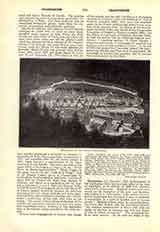

Chartreuse, LA GRANDE.—The mother-house of the Carthusian Order lies in a high valley of the Alps of Dauphine, at an altitude of 4268 feet, fourteen miles north of Grenoble. Medieval writers were awe-struck by the desolation of the spot, and Marten, who visited it in 1760, writes: “One cannot conceive how it could enter into the mind of man, to establish a community in a spot so horrible and so barren as this.” Modern writers praise its picturesqueness, but some, like Ruskin, find the mountains around, “the simplest commonplace of Savoy cliff, with no peaks, no glaciers, no cascades, nor even any slopes of pine in extent of majesty”. The monastery lies in an open pasture. On the east the ridge of the Grand-Som towers above its roof, on the south the road approaches through a narrow gorge, while on the north and west the valley is shut in by heights covered with woods, due to the planting of the earlier monks, but now the property of the State. The first monastery, built by St. Bruno in 1084 on the spot marked by the chapel of Notre-Dame de Casalibus, was destroyed by an avalanche in 1132, and the new buildings were erected on part of the site of the present grand cloitre. The monastery was burnt eight times between 1320 and 1676. At the latter date the prior, Innocent Le Masson, began to rebuild the greater part of it in the somewhat cold and heavy style of the period. His work was solid, and there is a severe monastic element about it. The buildings of today are substantially as he left them, though they have been extensively restored during the nineteenth century. They are on the typically Carthusian plan, with the addition of the great guest-houses and capitular hall, constructed to accommodate the Carthusian priors attending the general chapters, together with their attendants. The most ancient portions are the Gothic parts of the grand cloitre (over 700 feet long) and the church, which dates in part from 1320 or perhaps earlier, but owes its present form to restoration in the seventeenth and nineteenth centuries. The monastery, with a small portion of the surrounding pastures, was rented from the State till, in accordance with the Association Laws of 1901, the last monks were expelled by two squadrons of dragoons on the 19th of April, 1903. For the history of the monastery and order and for the famous liqueur see Carthusian Order.
RAYMUND WEBSTER

